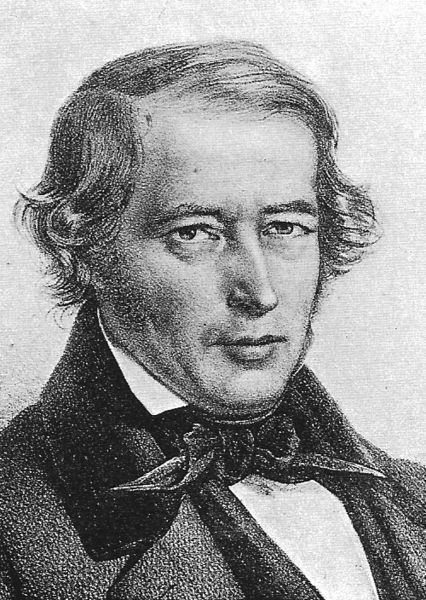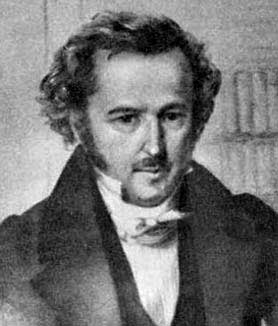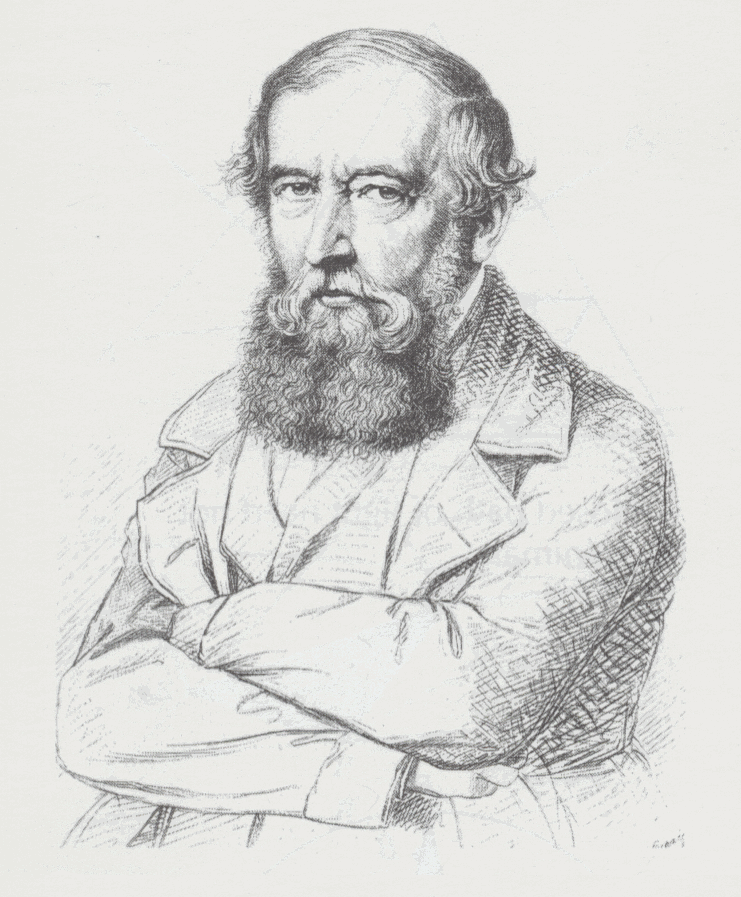<Back to Index>
- Mathematician Jakob Steiner, 1796
PAGE SPONSOR



Jakob Steiner (18 March 1796 – 1 April 1863) was a Swiss mathematician who worked primarily in geometry.
Steiner was born in the village of Utzenstorf, Canton of Bern. At eighteen he became a pupil of Heinrich Pestalozzi, and afterwards studied at Heidelberg. Thence he went to Berlin, earning a livelihood there, as in Heidelberg, by tutoring. Here he became acquainted with A.L. Crelle, who, encouraged by his ability and by that of N.H. Abel, then also staying at Berlin, founded his famous Journal (1826).
After Steiner's publication (1832) of his Systematische Entwickelungen he received, through C.G.J. Jacobi, who was then professor at Königsberg University, and earned an honorary degree there; and through the influence of Carl Gustav Jacob Jacobi and of the brothers Alexander and Wilhelm von Humboldt a new chair of geometry was founded for him at Berlin (1834). This he occupied until his death in Bern on 1 April 1863.
He was described by Thomas Hirst as follows:
- "He is a middle - aged man, of pretty stout proportions, has a long intellectual face, with beard and moustache and a fine prominent forehead, hair dark rather inclining to turn grey. The first thing that strikes you on his face is a dash of care and anxiety, almost pain, as if arising from physical suffering - he has rheumatism. He never prepares his lectures beforehand. He thus often stumbles or fails to prove what he wishes at the moment, and at every such failure he is sure to make some characteristic remark."
Steiner's mathematical work was mainly confined to geometry. This he treated synthetically, to the total exclusion of analysis, which he hated, and he is said to have considered it a disgrace to synthetic geometry if equal or higher results were obtained by analytical geometry methods. In his own field he surpassed all his contemporaries. His investigations are distinguished by their great generality, by the fertility of his resources, and by the rigor in his proofs. He has been considered the greatest pure geometer since Apollonius of Perga.
In his Systematische Entwickelung der Abhängigkeit geometrischer Gestalten von einander he laid the foundation of modern synthetic geometry. He introduces what are now called the geometrical forms (the row, flat pencil etc.), and establishes between their elements a one - to - one correspondence, or, as he calls it, makes them projective. He next gives by aid of these projective rows and pencils a new generation of conics and ruled quadric surfaces, which leads quicker and more directly than former methods into the inner nature of conics and reveals to us the organic connection of their innumerable properties and mysteries. In this work also, of which only one volume appeared instead of the projected five, we see for the first time the principle of duality introduced from the very beginning as an immediate outflow of the most fundamental properties of the plane, the line and the point.
In a second little volume, Die geometrischen Constructionen ausgeführt mittels der geraden Linie und eines festen Kreises (1833), republished in 1895 by Ottingen, he shows, what had been already suggested by J.V. Poncelet, how all problems of the second order can be solved by aid of the straight edge alone without the use of compasses, as soon as one circle is given on the drawing paper. He also wrote "Vorlesungen über synthetische Geometrie", published posthumously at Leipzig by C.F. Geiser and H. Schroeter in 1867; a third edition by R. Sturm was published in 1887 - 1898.
The rest of Steiner's writings are found in numerous papers mostly published in Crelle's Journal, the first volume of which contains his first four papers. The most important are those relating to algebraic curves and surfaces, especially the short paper Allgemeine Eigenschaften algebraischer Curven. This contains only results, and there is no indication of the method by which they were obtained, so that, according to L.O. Hosse, they are, like Fermat's theorems, riddles to the present and future generations. Eminent analysts succeeded in proving some of the theorems, but it was reserved to Luigi Cremona to prove them all, and that by a uniform synthetic method, in his book on algebraic curves.
Other important investigations relate to maxima and minima. Starting from simple elementary propositions, Steiner advances to the solution of problems which analytically require the calculus of variations, but which at the time altogether surpassed the powers of that calculus. Connected with this is the paper Vom Krümmungsschwerpuncte ebener Curven, which contains numerous properties of pedals and roulettes, especially of their areas.
Steiner also made a small but important contribution to combinatorics. In 1853, Steiner published a two pages article in Crelle's Journal on what nowadays is called Steiner systems, a basic kind of block design.